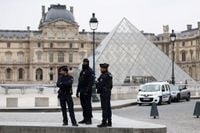In the heart of Paris, the Louvre Museum, a symbol of French culture and pride, has been shaken by a daring daylight robbery that stunned the nation and reverberated around the world. On October 19, 2025, amid the usual bustle of visitors, thieves executed an audacious heist, making off with eight precious objects valued at around $102 million. The incident has not only exposed significant security lapses at the world’s most visited museum but also triggered a swift and secretive response—one that has seen some of France’s most treasured jewels whisked away to the underground vaults of the Bank of France for protection.
According to reports from RTL and BFMTV, the transfer occurred early Friday morning, October 24, just five days after the robbery. A heavy police escort accompanied the operation, moving select pieces from the Apollo gallery—home to the French crown jewels—through the city’s streets. The destination was the Bank of France, whose massive vault lies 27 meters beneath the right bank of the Seine, a mere 500 meters from the Louvre itself. The bank, famed for storing the nation’s gold reserves, is now temporarily safeguarding some of the Louvre’s most precious remaining artifacts.
The decision to relocate the jewels was made in the wake of what French authorities have described as an “organized robbery.” The details of the crime are as cinematic as they are troubling. The thieves gained entry to the Louvre through a window, using a crane, and managed to slip away on motorbikes—all during the museum’s opening hours. The news, as reported by Reuters and Anadolu Agency, sparked a sense of national humiliation in France and ignited a debate over the security of its cultural treasures.
The list of stolen items reads like a catalog of French history: a necklace and an earring from the Marie-Louise collection, a necklace, earrings, and tiara from the Marie-Amélie and Hortense collections, and two brooches, a bodice bow, and a tiara from the Empress Eugenie collection. However, investigators did manage to recover one significant piece—Empress Eugenie’s crown—which was abandoned near the museum. A Louvre security guard, speaking on the matter, suggested that this discovery indicated the robbers’ plan “was thwarted.”
As the investigation unfolds, authorities are working around the clock to track down the perpetrators and recover the stolen treasures. Paris Prosecutor Laure Beccuau, in comments to Ouest-France, expressed cautious optimism: “Results in the coming days may open up leads, especially if the perpetrators were listed.” She revealed that over 150 DNA, papillary, and trace samples had been collected from the crime scene by October 23. “There’s a small hope that the perpetrators won’t dare move too much with the jewels,” Beccuau added, noting that the intense media coverage could put pressure on the suspects and disrupt their plans to sell or transfer the stolen items.
The robbery has also cast a harsh spotlight on the Louvre’s security protocols. Speaking before the Senate earlier in the week, Louvre President Laurence des Cars did not mince words about the museum’s vulnerabilities. “We did not detect the arrival of the thieves sufficiently in advance,” she admitted, citing an “insufficient video pool” and “serious problems with security posts.” These revelations have fueled criticism and concern among the French public, who view the museum not just as a tourist attraction, but as a vital custodian of the nation’s heritage.
French Culture Minister Rachida Dati has found herself at the center of the debate, defending the steps taken to reinforce security at the Louvre and other major cultural sites across France. Dati denounced what she described as “false information circulating” about the museum’s security systems and insisted that efforts to bolster protection are ongoing and robust. Still, the incident has raised uncomfortable questions about whether enough has been done to safeguard priceless artifacts in a world where criminal ingenuity appears boundless.
The Bank of France, for its part, has maintained a characteristically tight-lipped stance, declining to comment on the specifics of the transfer. The Louvre, too, has remained silent, perhaps wary of revealing any details that could compromise the ongoing investigation or the safety of the collection. For now, the jewels rest in one of the most secure vaults in the country, their fate—and that of the stolen pieces—uncertain.
The sense of loss and vulnerability is palpable in Paris. The Louvre’s Apollo gallery, usually a glittering showcase of history, now stands partially empty, its most precious objects hidden from public view. The theft itself has been described as unprecedented, not just for the value of the items stolen, but for the brazenness with which it was carried out. The fact that the robbers struck during daylight, using heavy equipment and escaping in plain sight, has led many to question how such a breach could occur at one of the world’s most closely watched museums.
For the French public, the episode has struck a nerve. The crown jewels and other artifacts housed at the Louvre are more than mere objects; they are symbols of national identity, resilience, and cultural achievement. Their sudden vulnerability has prompted calls for a thorough review of museum security not only at the Louvre but at institutions across France. Some have even suggested that the incident represents a wake-up call—a reminder that even the most iconic treasures are not immune to modern threats.
Meanwhile, investigators continue to sift through evidence, hoping that the more than 150 samples collected will yield a breakthrough. The widespread media attention, authorities hope, will make it harder for the thieves to sell or move the stolen jewels. As Beccuau noted, the pressure is on: “There’s a small hope that the perpetrators won’t dare move too much with the jewels.”
As Paris waits for answers, the Louvre’s remaining treasures lie deep beneath the city, protected by layers of steel and concrete. Whether they will soon return to their rightful place in the Apollo gallery—or whether the stolen jewels will ever be recovered—remains to be seen. For now, the world watches, and the City of Light holds its breath, hoping that justice, and perhaps a little luck, will soon restore what was lost.

